Choosing the right grass for your climate makes the difference between a thriving lawn and a constant struggle. The wrong grass type leads to brown patches, high water bills, and endless frustration. This guide breaks down exactly which grasses work best in each climate zone.
Understanding Climate Zones for Grass Selection
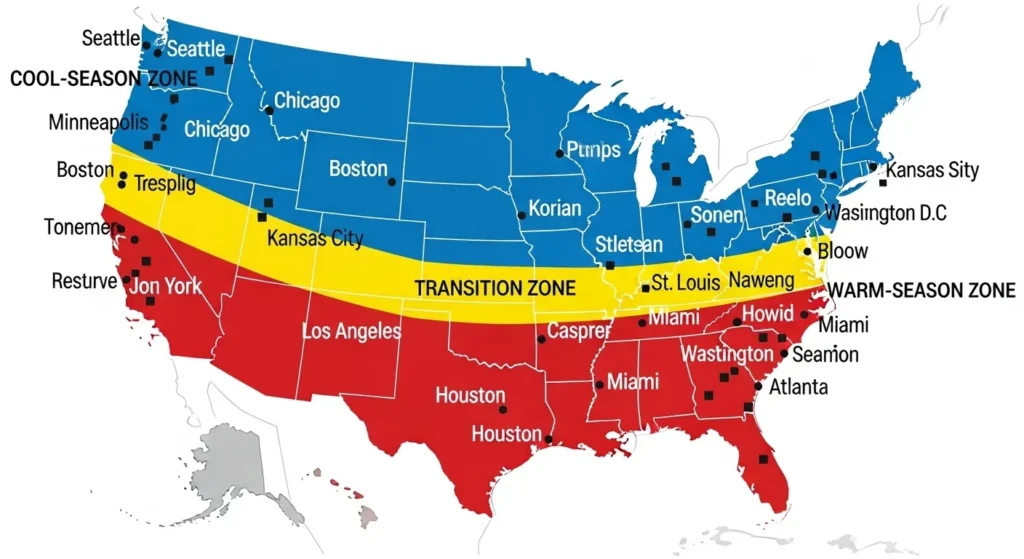
The United States divides into three main grass-growing regions. The northern two-thirds supports cool-season grasses that love moderate temperatures. The southern tier works best with warm-season varieties that handle intense heat. The middle section, called the transition zone, presents unique challenges where both types can work.
Cool-Season Zone: Northern states including New England, Upper Midwest, High Plains, Northern California, and Pacific Northwest
Warm-Season Zone: Southern states from Texas to Florida and up through coastal areas
Transition Zone: Mid-Atlantic states through Oklahoma and Nebraska
Cool-Season Grasses: Best for Northern Climates
Cool-season grasses grow actively during spring and fall when temperatures range from 60-75°F. They can handle frost and cold winters but struggle in extreme summer heat.
Kentucky Bluegrass
Kentucky bluegrass creates the classic American lawn with its rich green color and fine texture. This perennial grass spreads through underground stems called rhizomes, helping it fill in bare spots naturally.
Best for: Areas with cold winters and moderate summers Sunlight: Full sun to partial shade Maintenance: High – requires regular watering and fertilizing Traffic tolerance: Good when healthy
Kentucky bluegrass needs consistent moisture to stay green during summer heat. Without adequate water, it goes dormant and turns brown until cooler weather returns.
Tall Fescue
Tall fescue stands out as the workhorse of cool-season grasses. Its deep root system reaches down 2-3 feet, making it highly drought tolerant once established.
Best for: Transition zones and areas with hot summers Sunlight: Full sun to partial shade
Maintenance: Low to moderate Traffic tolerance: Excellent
This grass type handles foot traffic better than most others. It works well for families with children and pets. Keep tall fescue at 3-4 inches tall for best results.
Fine Fescue
Fine fescue includes several varieties like red fescue and chewing fescue. These grasses excel in challenging conditions where other types fail.
Best for: Shady areas and low-maintenance lawns Sunlight: Partial shade to full shade Maintenance: Very low Traffic tolerance: Poor to fair
Fine fescue rarely needs watering after establishment. It grows slowly and requires less frequent mowing than other grass types.
Perennial Ryegrass
Perennial ryegrass germinates quickly, making it perfect for overseeding and quick lawn repairs. It establishes faster than any other cool-season grass.
Best for: Quick establishment and overseeding Sunlight: Full sun to partial shade Maintenance: Moderate Traffic tolerance: Good
This grass works well in seed mixtures because it provides quick coverage while slower grasses like Kentucky bluegrass establish.
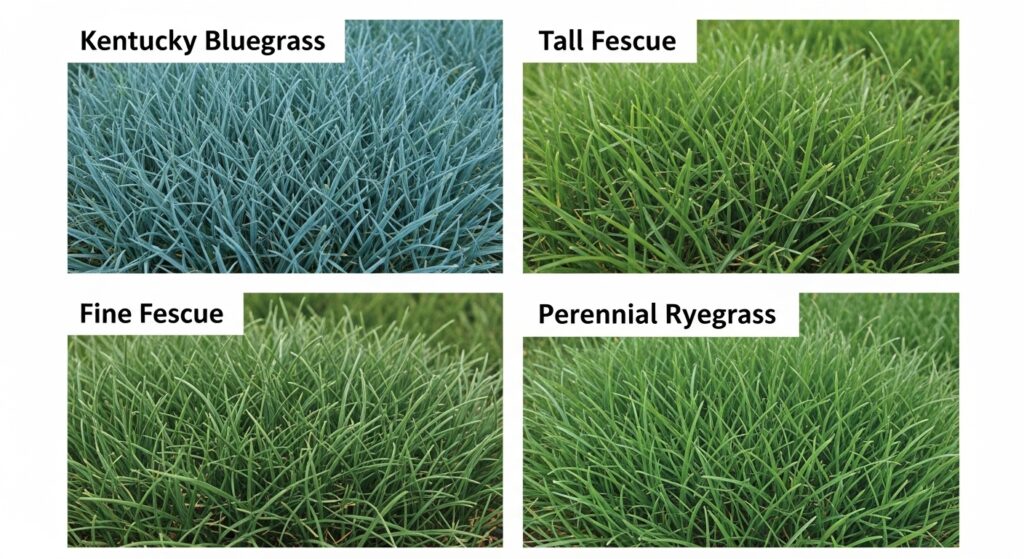
Warm-Season Grasses: Perfect for Southern Heat
Warm-season grasses thrive when temperatures climb above 80°F. They grow most actively during summer months and go dormant when temperatures drop below 50°F.
Bermuda Grass
Bermuda grass dominates southern lawns because of its exceptional heat and drought tolerance. This aggressive spreader fills in quickly and handles heavy foot traffic.
Best for: Hot, sunny areas with high traffic Sunlight: Full sun (6+ hours daily) Maintenance: High – fast growth requires frequent mowing Traffic tolerance: Excellent
Bermuda grass spreads through both above-ground runners and underground rhizomes. It can become invasive and spread into flower beds without proper edging.
Zoysia Grass
Zoysia creates a carpet-like lawn that feels soft underfoot. Once established, it forms such a thick mat that weeds rarely penetrate.
Best for: Moderate traffic areas in warm climates Sunlight: Full sun to partial shade Maintenance: Low to moderate Traffic tolerance: Good
Zoysia grows slowly but creates a dense, beautiful lawn. It handles drought well due to its deep root system. This grass may need dethatching every few years.
St. Augustine Grass
St. Augustine grass works well in coastal areas because of its salt tolerance. It creates a thick, coarse-textured lawn that stays green in mild winters.
Best for: Coastal areas and humid climates Sunlight: Full sun to moderate shade Maintenance: Low – many homeowners only need to mow Traffic tolerance: Fair
This grass chokes out weeds naturally but can be difficult to repair if damaged. St. Augustine typically requires plugs rather than seed for establishment.
Centipede Grass
Centipede grass earns the nickname “lazy man’s grass” because of its low maintenance requirements. It grows slowly and needs minimal fertilizer.
Best for: Low-traffic areas in the Southeast Sunlight: 6 hours of sun minimum Maintenance: Very low Traffic tolerance: Poor
This apple-green grass prefers acidic, sandy soils common in southeastern states. It may stay green year-round in very mild climates.
Buffalo Grass
Buffalo grass stands as America’s most drought-tolerant lawn grass. This native prairie grass can survive on natural rainfall in many areas.
Best for: Arid western regions and water-conscious homeowners Sunlight: Full sun Maintenance: Very low once established Traffic tolerance: Fair
Buffalo grass turns brown with the first frost but greens up quickly in spring. It requires little to no fertilizer and minimal mowing.
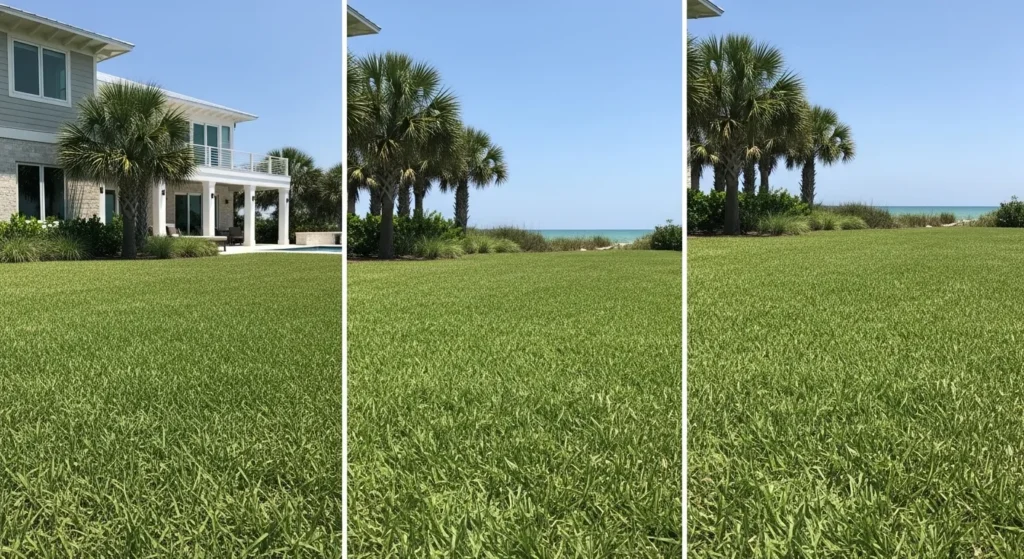
Transition Zone Challenges and Solutions
The transition zone presents unique challenges because neither cool-season nor warm-season grasses perform perfectly. Summers get too hot for cool-season grasses, while winters prove too cold for many warm-season varieties.
Best Transition Zone Options
Tall Fescue: The top choice for most transition zone lawns because of its heat and cold tolerance
Zoysia Grass: Works well in the southern part of the transition zone
Fine Fescue: Good for shaded areas throughout the transition zone
Kentucky Bluegrass: Can work in the northern transition zone with proper care
Many transition zone homeowners use grass mixtures that combine different types for better overall performance.
Matching Grass to Your Specific Climate Conditions
Hot, Humid Climates
Best choices: Bermuda grass, St. Augustine grass, Zoysia grass
These locations need grasses that handle both high temperatures and moisture. All three options resist fungal problems common in humid conditions.
Hot, Dry Climates
Best choices: Buffalo grass, Bermuda grass, Bahia grass
Drought tolerance becomes critical in arid regions. These grasses survive on minimal water once established.
Cold, Wet Climates
Best choices: Tall fescue, fine fescue, perennial ryegrass
Northern areas with high rainfall need grasses that handle cold temperatures and excess moisture without developing disease problems.
Moderate Climates
Best choices: Kentucky bluegrass, tall fescue, perennial ryegrass mixtures
Areas with mild summers and winters can support the widest range of grass types.
Special Climate Considerations
Coastal Areas
Salt spray damages many grass types. St. Augustine grass and Bermuda grass handle salt exposure better than other varieties. Rinse your lawn occasionally if salt buildup becomes visible.
High Altitude Regions
Elevation affects temperature and growing season length. Choose grasses rated for your specific hardiness zone rather than relying on general regional recommendations.
Areas with Extreme Weather
Locations that experience both harsh winters and hot summers need the most resilient grasses. Tall fescue often performs best in these challenging conditions.
Seasonal Growth Patterns and Maintenance
Cool-Season Grass Calendar
Spring: Active growth begins – time for fertilizing and overseeding Summer: Growth slows – may go dormant without water Fall: Peak growing season – best time for major lawn work Winter: Dormant but stays green in most areas
Warm-Season Grass Calendar
Spring: Slow start – wait for soil to warm before planting Summer: Peak growth period – requires frequent mowing Fall: Growth slows as temperatures drop Winter: Dormant and brown in most areas
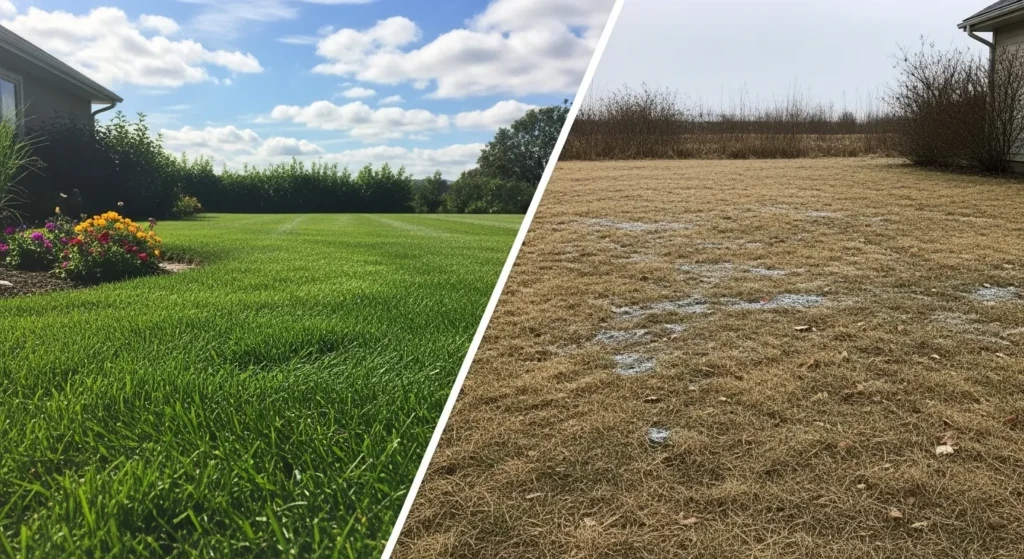
Common Mistakes to Avoid
Planting the Wrong Zone Grass
The biggest mistake homeowners make is choosing grass suited for a different climate. Cool-season grass planted in hot climates will struggle and require excessive watering. Warm-season grass in cold areas may die completely during winter.
Ignoring Sunlight Requirements
Grass needs vary dramatically based on sun exposure. Full-sun grasses planted in shade become thin and weak. Shade-tolerant varieties may not perform well in intense sunlight.
Poor Timing for Establishment
Plant cool-season grasses in early fall for best results. Warm-season grasses establish best in late spring when soil temperatures reach 65°F consistently.
Factors Beyond Climate
Soil Type Considerations
Clay soils: Choose grasses that handle poor drainage like tall fescue or St. Augustine Sandy soils: Pick varieties that tolerate quick-draining conditions like Bahia or centipede grass Rocky soils: Buffalo grass and fine fescue handle shallow, poor soils better than other types
Traffic and Use Patterns
High-traffic areas need durable grasses like Bermuda, tall fescue, or perennial ryegrass. Low-traffic zones can support delicate grasses like fine fescue or centipede grass.
Maintenance Preferences
Match your grass choice to the amount of work you want to do. Low-maintenance options include buffalo grass, fine fescue, and centipede grass. High-maintenance grasses like Kentucky bluegrass and creeping bentgrass require regular care but provide premium appearance.
Regional Grass Recommendations
Northeast (Maine to Pennsylvania)
Primary choices: Kentucky bluegrass, tall fescue, fine fescue Climate challenges: Cold winters, variable summers Best mixtures: Kentucky bluegrass with fine fescue for sun/shade areas
Southeast (Virginia to Florida)
Primary choices: Bermuda grass, St. Augustine grass, Zoysia grass Climate challenges: High heat, humidity, occasional drought Best for coastal areas: St. Augustine grass for salt tolerance
Midwest (Ohio to North Dakota)
Primary choices: Kentucky bluegrass, tall fescue, perennial ryegrass Climate challenges: Extreme temperature swings, variable precipitation Best mixtures: Tall fescue with Kentucky bluegrass for durability
Southwest (Texas to Arizona)
Primary choices: Buffalo grass, Bermuda grass, Zoysia grass Climate challenges: Extreme heat, drought conditions Water-wise choice: Buffalo grass for minimal irrigation needs
West Coast (California to Washington)
Primary choices: Vary by specific microclimate Northern areas: Cool-season grasses Southern California: Warm-season grasses Mediterranean climates: Tall fescue or Zoysia grass
Mountain West (Colorado to Montana)
Primary choices: Fine fescue, buffalo grass, tall fescue Climate challenges: Short growing seasons, temperature extremes Altitude considerations: Choose grasses rated for your elevation
Making the Final Decision
Start by identifying your exact climate zone and typical weather patterns. Consider these key questions:
- What are your average summer and winter temperatures?
- How much annual rainfall does your area receive?
- How many hours of direct sunlight does your lawn get?
- How much foot traffic will the grass experience?
- How much time do you want to spend on lawn maintenance?
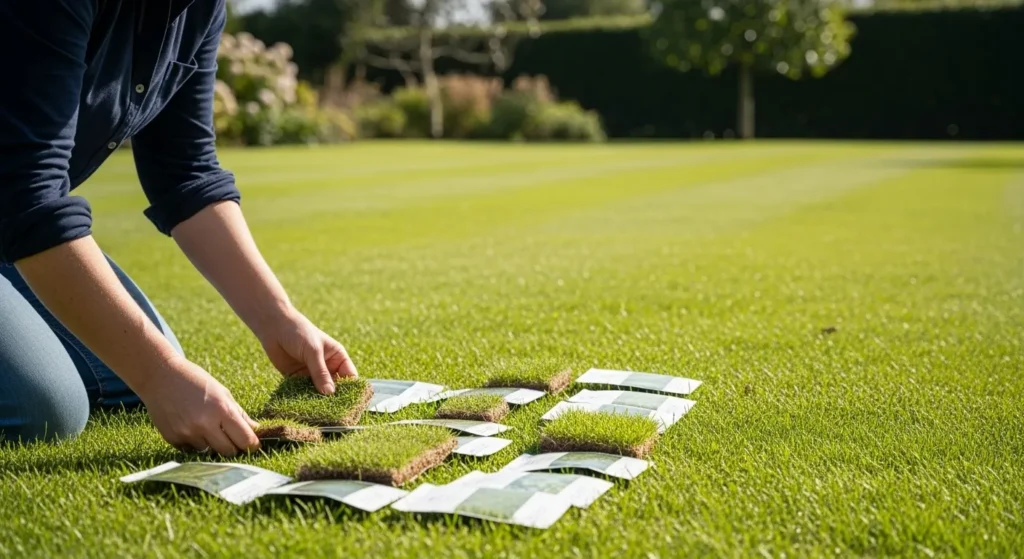
Contact your local county extension office for specific recommendations in your area. They understand local soil conditions, weather patterns, and grass performance better than general guides.
Remember that most successful lawns use grass mixtures rather than single varieties. These blends provide better overall performance across different conditions in your yard.
Frequently Asked Questions
What grass grows best in hot, dry climates? Buffalo grass and Bermuda grass handle heat and drought better than other varieties. Buffalo grass needs the least water once established.
Which grass stays green all winter? Cool-season grasses like Kentucky bluegrass and tall fescue stay green through winter in moderate climates. Warm-season grasses turn brown when temperatures drop.
Can I plant warm-season grass in a cold climate? Warm-season grasses may survive in borderline areas but will perform poorly and may die during harsh winters. Stick with grasses suited for your zone.
What grass requires the least maintenance? Fine fescue, buffalo grass, and centipede grass need minimal care once established. They require less water, fertilizer, and mowing than other types.
How long does it take for new grass to establish? Cool-season grasses typically establish in 6-8 weeks. Warm-season grasses take 8-12 weeks. Some varieties like Zoysia can take a full season to fill in completely.
Should I use grass seed or sod? Seed costs less but takes longer to establish. Sod provides instant results but costs more. Choose based on your budget and timeline.
The right grass type transforms your yard from a maintenance headache into a beautiful, low-stress landscape feature. Take time to match your grass choice to your specific climate and conditions for the best long-term results.
